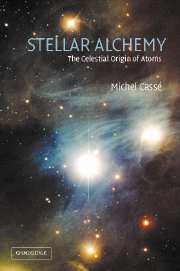Book contents
- Frontmatter
- Contents
- Preface
- Acknowledgements
- 1 Nuclear astrophysics: defence and illustration
- 2 Light from atoms, light from the sky
- 3 Visions
- 4 Contents of the sky: atomic sources and fountains
- 5 Nuclear suns
- 6 Sociology of stars and clouds
- 7 Histories
- 8 Ancient stars in the galactic halo
- 9 Conclusion
- Appendix 1 Invisible matter and energy
- Appendix 2 Supernovas and cosmology
- Appendix 3 Explosions
- Appendix 4 Stellar nucleosynthesis
- Appendix 5 Galactic evolution
- Appendix 6 Key dates
- Appendix 7 Constants and units
- Appendix 8 Websites
- Bibliography
- Index
2 - Light from atoms, light from the sky
- Frontmatter
- Contents
- Preface
- Acknowledgements
- 1 Nuclear astrophysics: defence and illustration
- 2 Light from atoms, light from the sky
- 3 Visions
- 4 Contents of the sky: atomic sources and fountains
- 5 Nuclear suns
- 6 Sociology of stars and clouds
- 7 Histories
- 8 Ancient stars in the galactic halo
- 9 Conclusion
- Appendix 1 Invisible matter and energy
- Appendix 2 Supernovas and cosmology
- Appendix 3 Explosions
- Appendix 4 Stellar nucleosynthesis
- Appendix 5 Galactic evolution
- Appendix 6 Key dates
- Appendix 7 Constants and units
- Appendix 8 Websites
- Bibliography
- Index
Summary
Matter with and without light
To begin with, how do astronomers know what stars are made of? The answer is that they have learnt to decode the language of light, of all the different kinds of light, be they visible or invisible. Atoms in stars speak to atoms in eyes using the language of light. I say it now, and I will say it again until the message is clear. It is the identical nature of emitter and receiver that makes perception possible.
Light has become as a mother tongue for astronomers, a conscientious and light-footed messenger, speaking volubly in every region of space, transporting information from one point of the Universe to another. It is like an expressive covering for the atom. Carnal and material beings long believed that all matter was like itself composed of atoms. Materialism merged with atomism and was taught as a definitive doctrine. It is quite understandable that astronomy, science of light, would be tempted to confine the Universe to its visible aspect, imprisoning it somehow in its mere appearance.
Then suddenly, against her will but in all lucidity, Urania the ancient Greek muse of astronomy was compelled to admit that what is visible is only the froth of existence. She even came to give precedence to what cannot be seen, to what neither shines nor absorbs light. Astronomical observation and theoretical reasoning suggest that most of matter is actually invisible.
- Type
- Chapter
- Information
- Stellar AlchemyThe Celestial Origin of Atoms, pp. 11 - 16Publisher: Cambridge University PressPrint publication year: 2003



